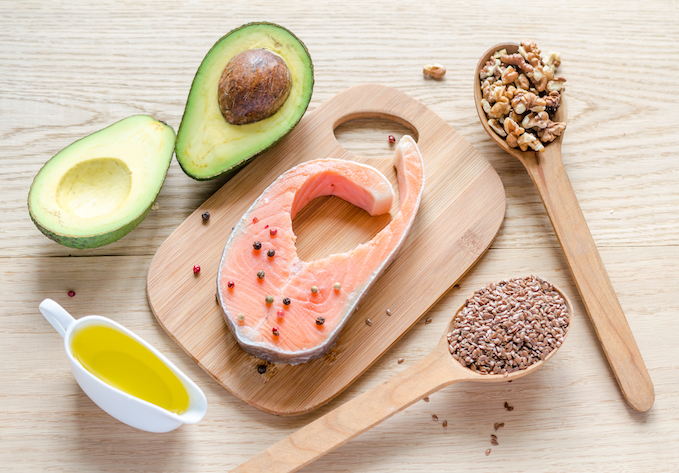What Is Fat And How Much Should You Get Each Day?

Many people don’t know exactly what to make of dietary fat these days.
Starting in the 1980s, dietary fat came under heavy attack, leading an entire generation to feel that eating fat made them fat.
Then, in the early 2000s, this completely changed with the popularity of the Atkins diet and the whole low-carb craze.
Fats were suddenly not so bad, and foods like red meat and cheese were no longer off limits; in fact, they were encouraged!
But what is the real story here?
In the end, fat is just another source of calories, which your body can break down to meet its energy needs.
In fact, your body can actually produce fat itself, so even if you don’t eat any dietary fat whatsoever, you can still get fat if you’re eating too many calories.
Fat is actually the most calorie dense of all the macronutrients, with each gram containing 9 calories.
This is one of the reasons why it has been long-suggested that people should moderate their fat intake – since it can be incredibly easy to overeat.
On the other hand, fat has various benefits which shouldn’t be ignored.
For one, it helps to give food its taste, and makes eating far more pleasurable!
In addition, eating fat can keep you feeling full for longer, which in turn can make you less likely to overeat.
Finally, there are other benefits that you can get from specific types of dietary fats – ranging from boosting your testosterone to decreasing your risk of getting all sorts of diseases.
The 4 Different Types Of Dietary Fat
There are actually 4 different types of fat in the human diet. Each of them is quite different, so let’s briefly look at each one.
Trans Fat
These have been getting a lot of bad press lately, and for good reason!
Trans Fats are made from hydrogenated vegetable oil, and have been linked to increased body fat, insulin resistance, and coronary heart disease.
They are generally found in processed foods, and provide absolutely no benefit whatsoever. They should be avoided whenever possible.
Monounsaturated Fat
In many ways, you can think of these as ‘neutral fats’.
They provide no concrete health benefits, but also don’t come with any real health risks.
Monounsaturated fats are found in foods like olive oil, and are featured heavily in Mediterranean diets.
However, if you need to increase your caloric intake for whatever reason, monounsaturated fats can be a great way to do this, since there are no known adverse health effects from overconsumption.
Saturated Fat
This one is a little bit more complicated.
For years, saturated fats were thought to be terrible for you, and responsible for increasing blood cholesterol levels.
In recent years, however, some people have started to claim that they’re good for you, and don’t carry such health risks.
The truth here is that it seems to depend largely on context.
If you are lean, active, eat fruits/vegetables, then consuming saturated fat within a sensible overall caloric intake has not been shown to have any impact on blood cholesterol.
On the other hand, if you are overweight, don’t eat fruits/vegetables, and eat too many calories overall, then saturated fat can increase the amount of cholesterol in your blood, leading to a greater risk of heart disease and stroke.
For the most part, saturated fat is found in meats and also in dairy products.
Polyunsaturated Fat
These are often what are considered the ‘good’ fats, but that doesn’t tell the whole story.
Broadly speaking, there are 2 different types of polyunsaturated fats – omega 3s and omega 6s.
The modern diet typically contains a ton of omega 6s, but very few omega 3s.
However, of all the the different types of fat, omega 3s provide by far the most benefits.
These include decreased inflammation, improved blood lipid levels, decreased risk of heart disease, decreased depression, joint health, and even fat loss.
Omega 3s are mainly found in fish, but also in omega-3 enriched eggs, and some free-range meat.
Realistically, unless you are eating a ton of fish, you won’t get enough omega 3s without taking a supplement.
If you’d like more information about fish oil supplements, then check out our detailed article here.
How Much Fat Should You Be Eating?
The exact amount will often depend on your goals and whether you tend to be an over-eater or an under-eater.
That being said, your fat intake should generally be 20-30% of your total caloric intake.
In terms of specifics, the only particular type of fat you need to get enough of, assuming your total intake is within these guidelines, is omega 3s.
You should aim for 1.8 grams per day to see minimum benefits – and up to 3 grams is recommended if you’re lifting weights and want the anti-inflammatory benefits.
List Of High Fat Foods
When trying to meet your fat requirements, here are some of the foods that you should focus on:
- Cheeses (any kind of cheese, cheddar, mozzarella, parmesan, etc)
- Nuts
- Nut butters (peanut butter & almond butter are great)
- Whole eggs (the fat is in the yolk, whereas the protein is in the white)
- Avocado/Guacamole
- Red meat (beef, pork)
- Certain fish (salmon)
- Butter
- Vegetable oil
- Olive oil
Remember, for most people, fat should make up the lowest percentage of your caloric intake.
This means that even though you should definitely not avoid eating fatty food, we would advise being moderate with your intake.